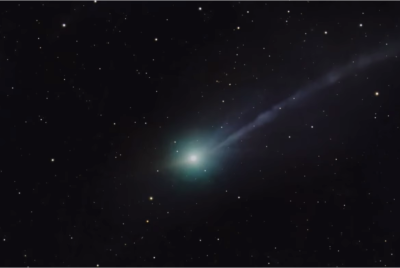ISRO Captures 3I/ATLAS in Unprecedented Detail — A Quiet Event With Big Impact
While its behaviour echoes local comets, JWST data shows an unusually high C02-to-H20 ratio

A distant comet, an unassuming observation, and a scientific outcome that's anything but small. The Indian Space Research Organisation (ISRO) has quietly delivered a significant punch to the world of astronomy by successfully capturing details of the interstellar object 3I/ATLAS, never before seen.
India's Space Agency Reveals Striking View of 3I/ATLAS
The ISRO has a remarkable image of 3I/ATLAS, taken with its 1.2-metre Mount Abu telescope. This view, captured during a brief observation in mid-November, shows the comet's vivid core encased in a pale, greenish-blue atmosphere.
This cloud of material grows larger as the object moves nearer to the interior of the Solar System and heats up. According to the ISRO website, spectroscopic readings from the same observation period showed evidence of gas molecules, many of which are standard indicators of a comet's usual behaviour.
Physical Research Laboratory (PRL) used its 1.2 m telescope at Mount Abu to observe the interstellar comet 3I/ATLAS post-perihelion.
— ISRO (@isro) November 19, 2025
For more information visithttps://t.co/hGs5FcDa44
#SpaceScience #Astronomy #DOS pic.twitter.com/ZgywJbWfm9
The rate at which these gases are being created — a figure that shows how quickly the comet is losing mass — indicates that 3I/ATLAS is acting very much like numerous comets that originated within our own planetary system, even though its source is from outside.
READ MORE: 3IATLAS: Why NASA Is Treating This Object Unlike Any Other Comet?
READ MORE: 3I/ATLAS Is Alive? New Preprint Claims Object Is a Plasmatic Organism
Understanding the Difference
Comets are frequently referred to as 'dirty snowballs' — cold, age-old structures composed of ice, stone, and organic compounds. Yet, 3I/ATLAS stands apart.
As only the third interstellar object ever confirmed — coming after Oumuamua in 2017 and Comet Borisov in 2019 — it has naturally attracted significant notice from the world's scientists.
In contrast to typical comets that come from the far-off Oort Cloud of our Solar System, these interstellar objects have journeyed from much greater distances, having been formed by the environments within completely separate star systems.
Interstellar object 3I/ATLAS as captured by:
— All day Astronomy (@forallcurious) November 19, 2025
Amateur astronomer $70 billion space-agency pic.twitter.com/KvDTnMkLaN
Meanwhile, the US space agency, NASA, on Wednesday made public new photographs of the interstellar object, obtained from various vantage points across the Solar System. Specifically, the HiRISE camera on board the Mars Reconnaissance Orbiter (MRO) captured a close-up image of the comet on 2 October, when it was a mere 18.6 million miles (29.9 million km) away.
Evidence of Water Activity
Several days later, NASA's MAVEN probe captured ultraviolet images which showed a ring of hydrogen gas surrounding the comet. This observation clearly indicates that solar radiation is separating water molecules.
In another spectacular capture, the Lucy spacecraft, currently travelling toward Jupiter's Trojan asteroids, photographed 3I/ATLAS from a distance of about 240 million miles. These pictures, taken over time and combined, present a pale, indistinct centre encircled by a hazy atmosphere, followed by a slight tail.
READ MORE: Harvard's Avi Loeb Claims 3I/ATLAS Could Be 'Artificial' If No Gas Cloud Seen
READ MORE: 3I/ATLAS Reveals Unusual Tail Structure in New Mexico Photo, Igniting Debate
A Celestial Portrait
What becomes clear from all these observations is that an interstellar visitor looks and acts remarkably like a standard comet — despite its origin outside the Solar System. As NASA summarised, 'all evidence points to it being a comet', stressing that it is not an alien artefact.
Despite this, 3I/ATLAS remains a point of great interest among scientists. Analysis of infrared light from the James Webb Space Telescope (JWST) shows that the surrounding gas cloud is mostly carbon dioxide rather than water, with a CO2-to-H2O ratio far higher than expected.
This indicates that the comet's formation conditions were entirely dissimilar to those experienced by comets originating within our planetary system.
Significance Beyond Sight
For enthusiasts, finding this object will present a challenge. It remains dim, observable only with powerful telescopes when the weather is fine, and it is already moving quickly away from the Solar System.
However, researchers point out that the importance of 3I/ATLAS lies not in its appearance, but in the scientific information it provides about star-forming regions elsewhere.
As space agencies monitor the comet's path, 3I/ATLAS is providing astronomers with exceptional insights into what lies beyond our Solar System. It will soon vanish back into the void it originated from.
Still, the pictures and data collected today will help scientists understand how such interstellar objects are formed — and what they can tell us about the wider universe we inhabit.
© Copyright IBTimes 2025. All rights reserved.





















